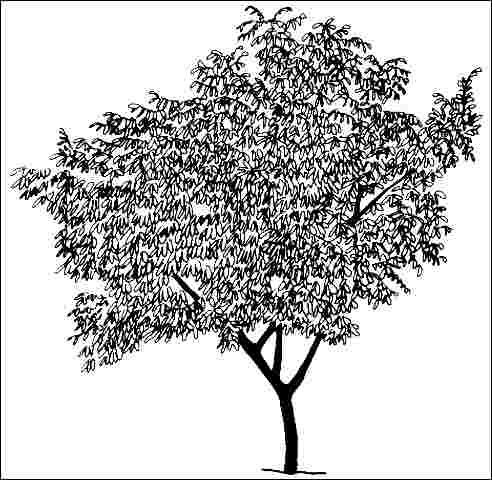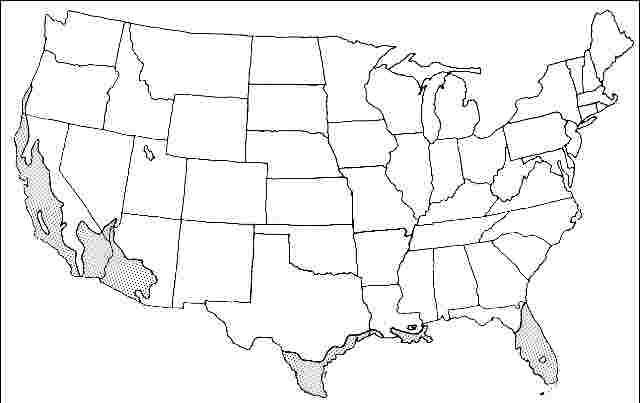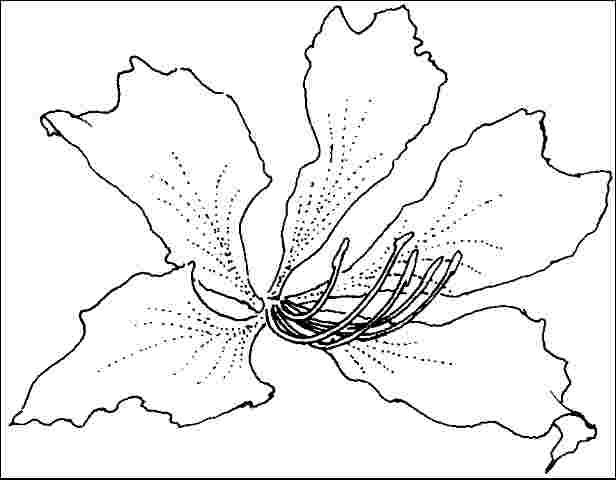Introduction
One of the hardiest of the bauhinias, white orchid-tree is a deciduous to semi-evergreen tree reaching 25 to 30 feet in height with interesting twisted ascending branches which droop at the ends, an often-leaning trunk, and large, bilobed, dark green leaves. The beautiful, white, three to four-inch-wide, orchid-like blooms appear in abundance from spring through summer and are followed by flat, dark brown seed pods. White Orchid-Tree makes a spectacular vase-shaped specimen, shade, or patio tree, or fits well into a mixed shrubbery border provided it is grown in the full sun. The trees propagated from seed vary in form when young from one individual to the next so uniform plantings are difficult to achieve. Trees become more uniform and symmetrical as they grow older. Probably too messy and sensitive to alkaline soil for a residential or downtown street tree but would grow well and be suited for a median strip where the debris would be washed away and less noticeable. Growth in alkaline soil is usually fine, but the leaves appear yellow between the veins.

General Information
Scientific name: Bauhinia aculeata
Pronunciation: bah-HIN-ee-uh ah-kew-lee-AY-tuh
Common name(s): White orchid-tree
Family: Leguminosae
USDA hardiness zones: 9A through 11 (Figure 2)
Origin: not native to North America
Invasive potential: According to the IFAS Assessment of Non-Native Plants in Florida's Natural Areas (UF/IFAS Invasive Plant Working Group 2008), Bauhinia aculeata is invasive and not recommended in Florida (to see if any exceptions for specified and limited use have been approved since publication, check the Conclusions Table at: http://plants.ifas.ufl.edu/assessment/conclusions.html).
Uses: shade; reclamation; street without sidewalk; deck or patio; specimen; parking lot island < 100 sq. ft.; parking lot island 100–200 sq. ft.; parking lot island > 200 sq. ft.; tree lawn 3–4 feet wide; tree lawn 4–6 feet wide; tree lawn > 6 ft. wide; highway median
Availability: not native to North America

Description
Height: 25 to 30 feet
Spread: 15 to 25 feet
Crown uniformity: symmetrical
Crown shape: vase
Crown density: moderate
Growth rate: fast
Texture: coarse
Foliage
Leaf arrangement: alternate (Fig. 3)
Leaf type: simple
Leaf margin: cleft, lobed
Leaf shape: orbiculate
Leaf venation: palmate
Leaf type and persistence: deciduous
Leaf blade length: 2 to 4 inches
Leaf color: green
Fall color: no color change
Fall characteristic: not showy

Flower
Flower color: white/cream/gray
Flower characteristics: showy

Fruit
Fruit shape: elongated, pod or pod-like
Fruit length: 6 to 12 inches
Fruit covering: dry or hard
Fruit color: brown
Fruit characteristics: does not attract wildlife; showy; fruit/leaves a litter problem
Trunk and Branches
Trunk/bark/branches: branches droop; not showy; can be trained to one trunk; thorns
Pruning requirement: needed for strong structure
Breakage: susceptible to breakage
Current year twig color: brown
Current year twig thickness: thin, medium
Wood specific gravity: unknown
Culture
Light requirement: full sun, partial sun or partial shade
Soil tolerances: clay; sand; loam; acidic; slightly alkaline; well-drained
Drought tolerance: high
Aerosol salt tolerance: moderate
Other
Roots: not a problem
Winter interest: no
Outstanding tree: no
Ozone sensitivity: unknown
Verticillium wilt susceptibility: unknown
Pest resistance: free of serious pests and diseases
Use and Management
Orchid-tree benefits from some pruning early in their life to increase branchiness and to produce a form which will be suited for most landscapes. Left unpruned, many trees are beautiful, forming multiple trunks and branches close to the ground which is fine for specimen use in a lawn area or other open-space landscapes. Purchase trees with one trunk for parking lot or other urban landscapes where vehicular clearance will be necessary. Be sure to train branches so they will grow up before they spread out. If this is not done, lower branches will droop toward the ground and they may have to be removed, disfiguring the tree. Orchid trees drop fruit, small branches and leaves periodically so some people consider it a messy tree. But regularly fertilized, orchid-tree is a wonderful flowering tree.
Growing in full sun or high, shifting pine shade, orchid-tree thrives in any well-drained soil but in alkaline soils will show interveinal chlorosis (yellowing) on the leaves. Potassium deficiency shows up as necrosis, magnesium deficiency as chlorosis. Although tolerant of drought, white orchid-tree can benefit from some afternoon shade, or irrigation, in hot, dry weather to prevent the blooms from shrivelling up. The flowers are followed by many brown, woody seed pods which fill the tree and could be considered unattractive on the tree in the winter and a nuisance when they drop.
Propagation is by seed, suckers, layerings, or cuttings.
Pests and Diseases
No pests or diseases are of major concern. Potassium, magnesium, and micronutrient deficiencies are common. Orchid-tree seeds itself into the landscape.
Literature Cited
Fox, A.M., D.R. Gordon, J.A. Dusky, L. Tyson, and R.K. Stocker. 2008. UF/IFAS Assessment of Non-Native Plants in Florida's Natural Areas: Status Assessment. http://plants.ifas.ufl.edu/assessment/pdfs/status_assessment.pdf (November 16, 2012)